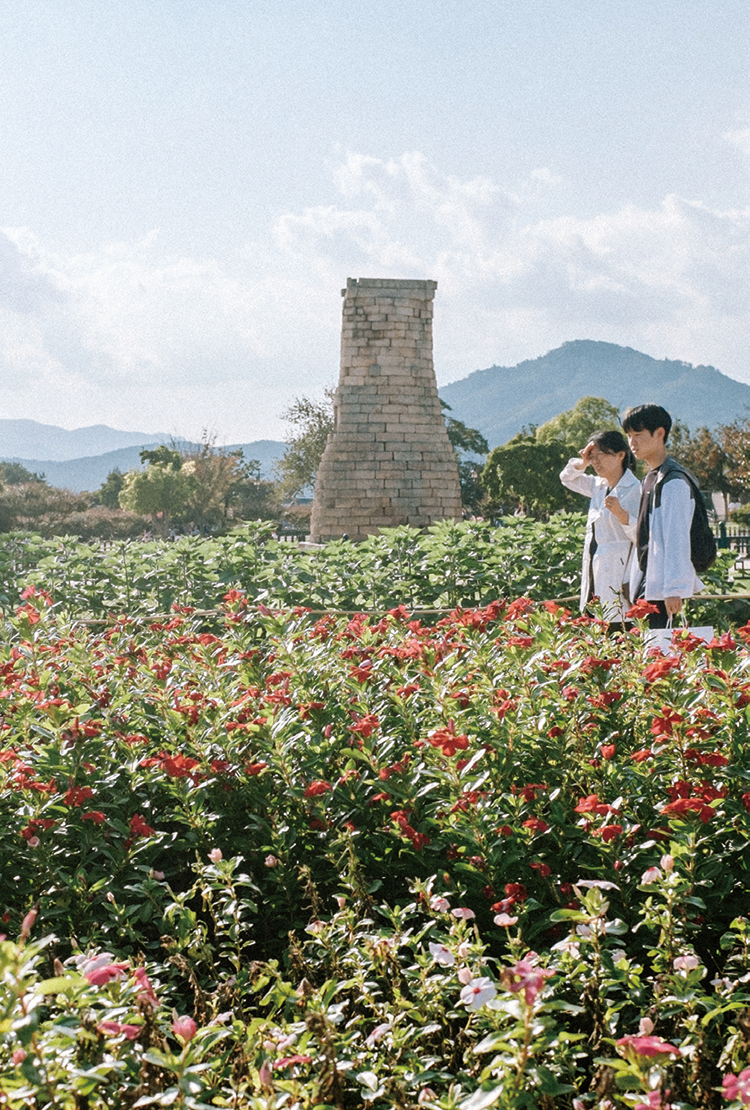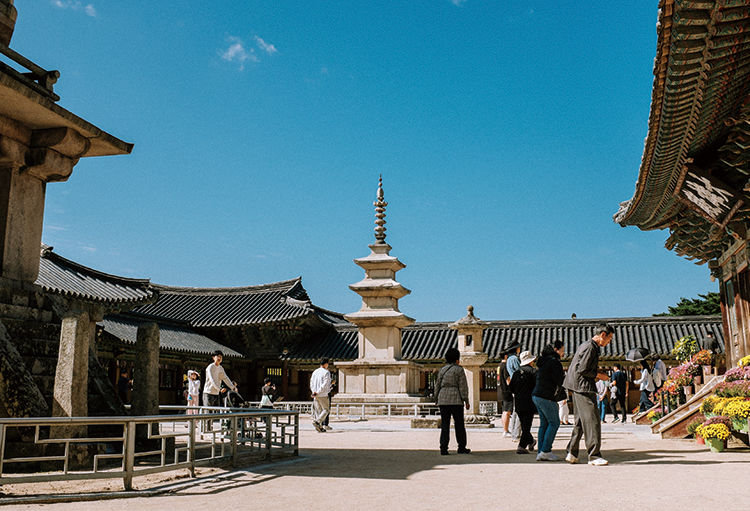Likely to Revisit
The Power of Seasons
Gyeongju
Autumn is here to stay. For some reasons, I tend to look into myself more in fall than in any other seasons and take great pleasure in doing so. Discovering who I am is always a wonderful experience. In Gyeongju, the beautiful season of autumn easily takes me on a soul-searching journey, and the fog floating over the field of my mind clears little by little.
📝Text & 📷Photos by. Jae-hyeon Park, Novelist

Cheomseongdae
A Gift of the Season
How can an astronomical observatory built for stargazing be so lovely? Cheomseongdae, which looks like a pretty stone pagoda, was built to foresee events of the future for the state. The square bottom and the round-shaped top are symbolic embodiments of earth and heaven, respectively. In fall, people visit Gyeongju not to view Cheomseongdae but to see the plants around it. Pink Muhly grass is particularly alluring. The bright, vivid pink color of Pink Muhly in full bloom is ideal for a photo zone. Seen from a distance, Pink Muhly grass—a member of the rice family—looks hazy and blurry in shape, which reminds me of the way I want things to look when I want to hide my true feelings.
It looks even more dreamy and lovely with the analogy coming to mind. There is a large section of pampas grass as well. A reed-like plant native to South America, pampas grass also plays a supporting role in creating an enchanting landscape of autumn. Even from a distance, the densely layered leaves reveal themselves clearly under the autumn sunlight, making me think, "Autumn is here, indeed."
In Fall, Cheomseongdae Becomes Surrounded with Flowers. In addition to Pink Muhly grass and pampas grass, there are flower gardens featuring chrysanthemums, zinnia, globe amaranths, and cockscombs, presenting an aesthetically pleasing sight.
Bulguksa
The Dream of Silla People
As a Buddhist temple of the Silla kingdom, Bulguksa is as same as ever, but the surrounding landscape looks slightly different every time I visit the temple. More and more foreign tourists are visiting the temple as time passes. Foreign tourists may find some of the must-visit tourist attractions falling short of their expectations, but I can proudly assure them that Bulguksa is truly a masterpiece of Korean heritage that they must visit. Even the name says it all as it means “the nation of Buddha." It epitomizes the dream of the Silla people. I can imagine Silla people coming to the temple and praying to Buddha with a solemn, sincere mind. I wonder what they were thinking about as they slowly walked to cross Cheongwungyo Bridge and Baegungyo Bridge until Seokgatap Pagoda and Dabotap Pagoda finally came into view. In Daeungjeon Hall, they probably prayed for the health and wellbeing of their family members. They cannot have skipped Geungnakjeon Hall right next to it. What did paradise, mean to them? I suppose it is not an unknown, elusive ideal of what we only dream of, but perhaps the joy of walking around Bulguksa with loved ones.
If you are at Bulguksa, be sure to check out Banyayeonji. Haetalgyo including the pond as seen from across Haetagyo Bridge is spectacular. You should visit the pond when the autumn foliage is at its best.
Daereungwon Ancient Tombs
Peace from the kings
How can it be so peaceful to walk around tombs of the dead? Does this sense of peace come from the kings buried in the tombs? Looking at the giant royal tombs makes me feel relaxed. The sheer size of the tombs attests to the amount of respect that people had for their kings. If you look up a little, only the sky and the tombs come into view. Looking at the blue sky gives comfort to your eyes and makes you forget about the hustle and bustle of the city for a while. The trees surrounding the royal tombs make them look even more majestic. The trees are not overgrown. Instead, they are placed in a well-balanced layout, adding a sense of picturesque elegance to the royal tombs. The area is known for cherry blossoms in spring and foliage in fall. After touring all the tombs, be sure to walk on the stone-wall trail outside of Daereungwon Royal Tomb. Indeed, it is a rare, romantic experience to walk on fallen leaves along the low-lying stone wall.
Standing behind Hwangnam DaeChong, the Great Tomb of Hwangnam, is a huge magnolia. Rising between the tombs, it makes for an excellent photo zone. You can rent hanbok from a nearby hanbok rental shop and wear it to take selfies. How about drinking coffee at a café offering a nice view of the royal tomb through a giant glass window?
Donggung Palace & Wolji Pond
A picture painted by a pond
This is the site of a secondary palace called Donggung Palace of the Silla kingdom. It was a palace where the crown prince of Silla resided. Wolji means “moonlit pond." When I get here, I find myself walking slowly around the pond before I know it. As I take a pleasant walk on the clay path, feeling the cool, crisp air and the warmth of the moonlight, I put myself in his shoes and imagine how the crown prince would have felt. The best part, however, is the pond. It feels quite different depending on where you are because the pond is filled with islets and floating plants, from which I can choose what to enjoy. The reflection of the sky and clouds on the pond keeps catching my eye. When night falls and lights are turned on, the pond reveals a new face. The enchanting serenity of the peaceful night scene causes viewers to keep taking photos of it. Obviously, this must have been the best night view spot at the time even in the absence of modern lighting because the moon did all the trick.
Known for the exceptionally beautiful night view, Donggung and Wolji Pond are a major nighttime attraction, but it is probably a better idea to be there before the sunset if you want to enjoy best the changing scenery of the pond against the evolving sky scenery. The evening scenery against the sunset is as fascinating as the night view of the pond.













